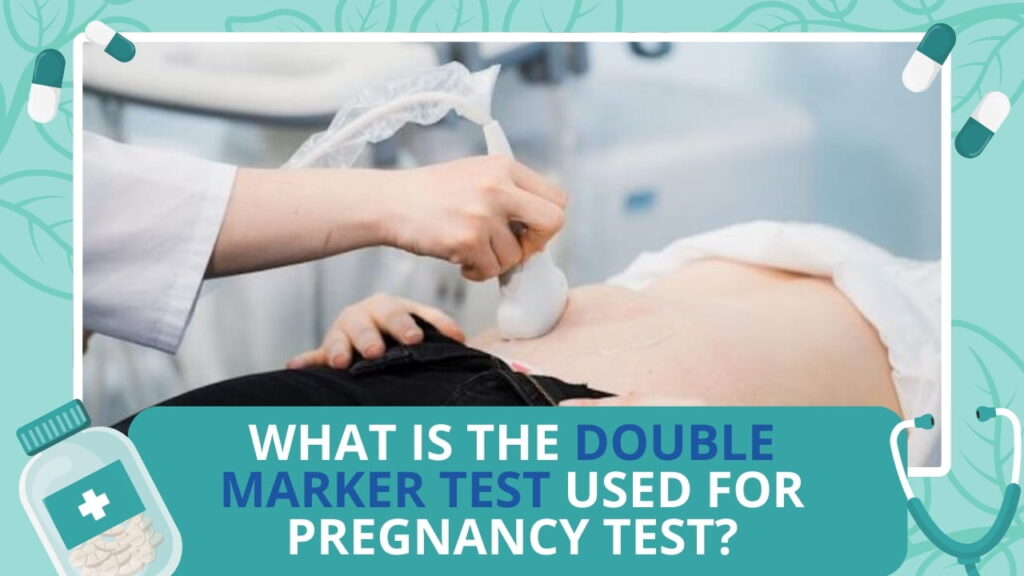Last updated on May 21st, 2025 at 01:08 pm
 In the realm of prenatal care, expectant mothers are often bombarded with various tests and procedures aimed at ensuring the health and well-being of both mother and baby. One such test that has gained prominence in recent years is the Double Marker Test. This diagnostic tool serves a crucial role in identifying potential risks associated with pregnancy, particularly concerning chromosomal abnormalities and neural tube defects. In this comprehensive guide, we delve into what the Double Marker Test entails, its significance, benefits, and alternative approaches.
In the realm of prenatal care, expectant mothers are often bombarded with various tests and procedures aimed at ensuring the health and well-being of both mother and baby. One such test that has gained prominence in recent years is the Double Marker Test. This diagnostic tool serves a crucial role in identifying potential risks associated with pregnancy, particularly concerning chromosomal abnormalities and neural tube defects. In this comprehensive guide, we delve into what the Double Marker Test entails, its significance, benefits, and alternative approaches.
What is the Double Marker Test?
The Double Marker Test, also known as the Dual Marker Test, is a blood test primarily performed during the first trimester of pregnancy, typically between 8 to 14 weeks. It involves measuring two specific biochemical markers in the maternal bloodstream: pregnancy-associated plasma protein-A (PAPP-A) and free beta-human chorionic gonadotropin (β-hCG). These markers are indicative of the risk of certain chromosomal abnormalities, notably Down syndrome (trisomy 21), Edwards syndrome (trisomy 18), and neural tube defects such as spina bifida.
How Does the Double Marker Test Work?
During pregnancy, the placenta plays a pivotal role in supplying essential nutrients and hormones to support fetal development. Among these hormones are PAPP-A and β-hCG, which enter the maternal bloodstream. Abnormal levels of these markers may indicate an increased risk of certain chromosomal abnormalities, such as Down syndrome (trisomy 21), Edwards syndrome (trisomy 18), or neural tube defects like spina bifida, in the developing fetus.
The Double Marker Test analyzes the concentrations of PAPP-A and β-hCG in the maternal blood sample. These measurements are then interpreted alongside maternal age and gestational age to calculate the overall risk of chromosomal abnormalities and neural tube defects. The test results are typically reported as multiples of the median (MoM), comparing the measured values to expected normal ranges for the corresponding gestational age.

Purpose and Utility of the Double Marker Test
Screening for Chromosomal Abnormalities
One of the primary purposes of the Double Marker Test is to screen for chromosomal abnormalities, particularly Down syndrome (trisomy 21) and Edwards syndrome (trisomy 18). Elevated or decreased levels of PAPP-A and β-hCG in the maternal bloodstream may indicate an increased risk of these chromosomal abnormalities in the developing fetus.
Detection of Neural Tube Defects
In addition to chromosomal abnormalities, the Double Marker Test is also used to assess the risk of neural tube defects, such as spina bifida. While less common than chromosomal abnormalities, neural tube defects can have significant implications for the baby’s health and development. Abnormal levels of the biochemical markers may prompt further evaluation and monitoring for the presence of neural tube defects.
Early Risk Assessment
By conducting the Double Marker Test during the first trimester of pregnancy, healthcare providers can identify potential risks early on, allowing for timely intervention, counseling, and appropriate prenatal care. Early detection of chromosomal abnormalities and neural tube defects enables expectant parents to make informed decisions about their pregnancy and plan for any necessary medical interventions or support services.
Non-Invasive Nature
Unlike invasive procedures such as amniocentesis or chorionic villus sampling (CVS), which carry a small risk of miscarriage, the Double Marker Test is non-invasive and poses minimal risk to both the mother and the fetus. This makes it a safer option for prenatal screening, particularly for women who may be reluctant to undergo invasive procedures.
Guidance for Further Testing and Counseling
Depending on the results of the Double Marker Test, healthcare providers may recommend additional diagnostic testing, such as amniocentesis or cell-free DNA testing, to confirm or rule out the presence of chromosomal abnormalities or neural tube defects. Genetic counseling is often provided to help expectant parents understand the implications of the test results and make informed decisions about their pregnancy.
Peace of Mind
For many expectant parents, undergoing prenatal screening tests such as the Double Marker Test can offer peace of mind by either confirming a low-risk pregnancy or identifying potential issues early on, enabling them to prepare emotionally and practically for any eventualities.
Alternatives to the Double Marker Test
While the Double Marker Test is widely used and considered effective in screening for chromosomal abnormalities and neural tube defects, there are alternative tests available, each with its own set of advantages and limitations:
- First-Trimester Combined Screening: This screening combines the measurement of maternal serum markers (PAPP-A and β-hCG) with ultrasound imaging, specifically nuchal translucency (NT) measurement. It offers similar information to the Double Marker Test but may provide a slightly different risk assessment.
- Cell-Free DNA Testing (cfDNA): Also known as non-invasive prenatal testing (NIPT), cfDNA testing analyzes fetal DNA fragments circulating in the maternal bloodstream. It is highly accurate in detecting chromosomal abnormalities, including Down syndrome, but may be more expensive than traditional screening tests.
- Second-Trimester Quadruple Marker Test: This test measures four biochemical markers in the maternal bloodstream—alpha-fetoprotein (AFP), unconjugated estriol (uE3), β-hCG, and inhibin A. It is typically performed between 15 to 22 weeks of gestation and can provide additional information about the risk of certain birth defects, such as neural tube defects and chromosomal abnormalities.

Conclusion
The Double Marker Test plays a crucial role in prenatal care by offering early detection and risk assessment for chromosomal abnormalities and neural tube defects. Its non-invasive nature, coupled with its ability to provide valuable information during the early stages of pregnancy, makes it a preferred choice for many expectant parents. However, it’s essential to understand that no screening test is 100% accurate, and further diagnostic testing may be recommended based on the results of the Double Marker Test or other screening modalities. Ultimately, the decision to undergo prenatal screening should be made in consultation with healthcare providers, taking into account individual circumstances and preferences.
FAQs on What Is The Double Marker Test Used For?
1. What Is The Double Marker Test Used For?
Answer: The Test is primarily used to screen for chromosomal abnormalities, such as Down syndrome (trisomy 21) and Edwards syndrome (trisomy 18), as well as neural tube defects like spina bifida. It measures the levels of two biochemical markers, PAPP-A and β-hCG, in the maternal bloodstream during the first trimester of pregnancy.
2. When is the Double Marker Test typically performed?
Answer: The Test is usually conducted between 8 to 14 weeks of gestation, during the first trimester of pregnancy. This early screening allows healthcare providers to assess the risk of chromosomal abnormalities and neural tube defects in the developing fetus, providing expectant parents with valuable information early on in their pregnancy journey.
3. How is the Double Marker Test different from other prenatal screening tests?
Answer: Unlike some other prenatal screening tests, such as ultrasound scans or quad marker tests, the Test specifically measures the levels of two biochemical markers—PAPP-A and β-hCG—in the maternal bloodstream. It offers early detection and risk assessment for chromosomal abnormalities and neural tube defects with minimal risk to both the mother and the fetus.
4. What are the implications of a positive Double Marker Test result?
Answer: A positive Test result may indicate an increased risk of chromosomal abnormalities or neural tube defects in the developing fetus. However, it’s important to note that the Test is a screening tool and not a definitive diagnostic test. Further diagnostic testing, such as amniocentesis or cell-free DNA testing, may be recommended to confirm or rule out the presence of these conditions, followed by genetic counseling to guide expectant parents through their options and next steps.
Also Read:-
- Best Creams for fungal infection in private area – Buy Fungal Infection Creams Online
- When Should I Start Using A Pregnancy Pillow? – How to Use a Pregnancy Pillow
- First-Time Sex: Can it lead to pregnancy? | Pregnancy Chances for Teens and Adults
- Pregnancy Test Kit | Pregnancy Test Instructions Manual